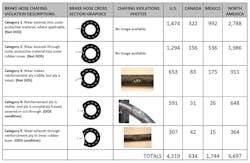CVSA releases 2020 Brake Safety Week results
Commercial Vehicle Safety Alliance (CVSA) held its 2020 Brake Safety Week on Aug. 23-29, and during the week-long inspection blitz, 12% of the 43,565 commercial vehicles inspected were placed out of service for brake-related violations.
Inspectors in North America removed 5,156 commercial motor vehicles from roadways due to brake violations during the week-long inspection and enforcement event, focused specifically on reducing brake-related crashes by conducting inspections and identifying and removing unsafe commercial motor vehicles from roadways.
In light of the coronavirus pandemic, jurisdictions that elected to participate in Brake Safety Week conducted inspections following each agency’s health and safety protocols and precautions in consideration of the health and well-being of inspectors and drivers.
In the U.S., 35,778 inspections were conducted; 4,565 vehicles (13%) were placed out of service for brake-related violations. In Mexico, 6% (355) of the 5,958 commercial motor vehicles inspected were placed out of service for brake-related violations. In Canada, 1,829 inspections were conducted, and the brake-related out-of-service rate was 14% (256).
Commercial motor vehicle inspectors throughout North America use the Commercial Vehicle Safety Alliance’s (CVSA) North American Standard Out-of-Service Criteria to identify critical vehicle inspection item violations that are concerning enough to warrant removing that vehicle from traveling on roadways until those conditions have been repaired.
Eighty-eight percent of the commercial motor vehicles inspected did not have brake-related critical vehicle inspection item violations. Vehicles that did not have any out-of-service conditions during a Level I or Level V Inspection may have received a CVSA decal. A decal, valid for up to three months, signifies that the vehicle was recently inspected by a CVSA-certified inspector and that vehicle had no critical vehicle inspection item violations.
In addition to capturing brake system out-of-service violation data, during this year’s Brake Safety Week, inspectors also recorded and submitted data regarding the chafing of brake hoses. Inspectors reported levels of brake hose chafing violations, separated into five categories based on the level of severity; two of which were out-of-service conditions, three were not.
A total of 6,697 hose chafing violations were reported in a separate data query from participating jurisdictions. Table 1 provides a reference key and details each category of chafing, along with the numeric totals for each category by country. Table 2 illustrates the frequency of each category of brake hose/tube chafing encountered by each country as a percentage of all hose chafing violations.
“Although many commercial motor vehicle enforcement agencies were forced to reduce services in the spring due to the pandemic, it was important that we resumed inspection and enforcement duties as soon as it was safe to do so,” said CVSA President John Samis. “With truck drivers designated ‘essential personnel’ by the government, we needed to ensure that the vehicles traversing our roadways were safe to support commercial drivers as they selflessly continued to work during such a difficult and challenging time.”


